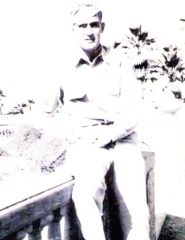David W. Stoddard

David W. Stoddard
DAVID
W.
STODDARD
SOLDIER DETAILS
BIOGRAPHY
With the three brothers inducted into the Armed Forces father Charles R and I decided it was our time to do something for the war effort. We enlisted in the 77th Company of the Massachusetts State Guard at Cohasset, Massachusetts in the summer of 1942. We reported once a week for training at the Ripley Road School auditorium. We received basic military training such as close order marching and manual arms using wooden rifles and shot guns. This basic training became very helpful to me once I enlisted in the Army Air Corps. On September 28th 1942 I received my discharge from the Massachusetts State Guard.
In August 1942 I decided to leave High School and join my three brothers in the Armed Forces. On September 30, 1942 I enlisted in the Army Air Corps at Boston, Massachusetts and was processed at Fort Devens, Massachusetts. After being processed I was transferred to Army Air Corps Classification and Training Center at Atlantic City, New Jersey. This Center was composed of many hotels along the Atlantic City boardwalk. I was assigned to room number 108 in the world famous Traymore Hotel. At this Center the Army Air Corps recruits received basic military training, medical exams, and a battery of technical skills tests. I was qualified to receive technical training as an aircraft and engine technician. My military training at this center was very limited because of my previous training with the Massachusetts State Guard.
In November 1942 I was selected to attend the Army Air Corps Technical School at Lincoln, Nebraska. This was a comprehensive sixteen week course on the inspection, repair and maintenance of all aircraft systems and engines. After completion of this school I requested special training on pursuit aircraft. In March 1943 I received orders to attend the Curtiss-Wright Aircraft Factory School in Buffalo, New York. This school was an accelerated four week course on the inspection, repair and maintenance of the P-40 aircraft. With the completion of this course I requested transfer to a P-40 unit in the combat theater.
At the end of April 1943 I received my first permanent base assignment to the 63rd Ferrying Squadron, 552nd Army Air Force Base Unit [2nd Ferrying Group] Ferrying Division, Air Transport Command, New Castle Army Air Base in Wilmington, Delaware. The Second Ferrying Group was one of seven groups in the Ferrying Division during World War Two. They delivered all types of aircraft throughout the world to support combat units. The Second Ferry Group was also the home of the first Women's Auxiliary Ferrying Squadron [WAFS], under the command of Lt. Col. Nancy Love.
It was at New Castle Army Air Base where I was issued my first tool box and was told to report to the Line Chief on the Pursuit aircraft flight line. The aircraft included two P-38s, a P-39, an old beat up P-40, and two P-47s. I was asked to crew the P-40 as I had just attended a course on this aircraft. Crew members were required to cross train on all aircraft on the flight line. These aircraft were used for pilot first flight check out and for proficiency flying.
In November 1943 I attended the Northrop Aircraft Factory Training School in Hawthorne, California. This was a one month advanced mechanics training course on the new P-61 aircraft. After completion of this school I requested a transfer to a P-61 squadron but I ended up back at New Castle Air Base Wilmington, Delaware. I was reassigned to the Medium Bomber Flight line crew which included B-26 and A-30 aircraft. These aircraft came directly from the factory. Ferry crews used these aircraft for training flights before delivering them to combat units around the world. My first aircraft flight was in a B-26 [ Better known as a Flying Coffin] while working on this flight line. The flight was to Fort Dix, New Jersey to check out a B-26 that had made an emergency landing because of an oil leak. I concluded that the problem was a leaking oil cooler and was replaced later by anoth
 Eisenhower Foundation
Eisenhower Foundation
